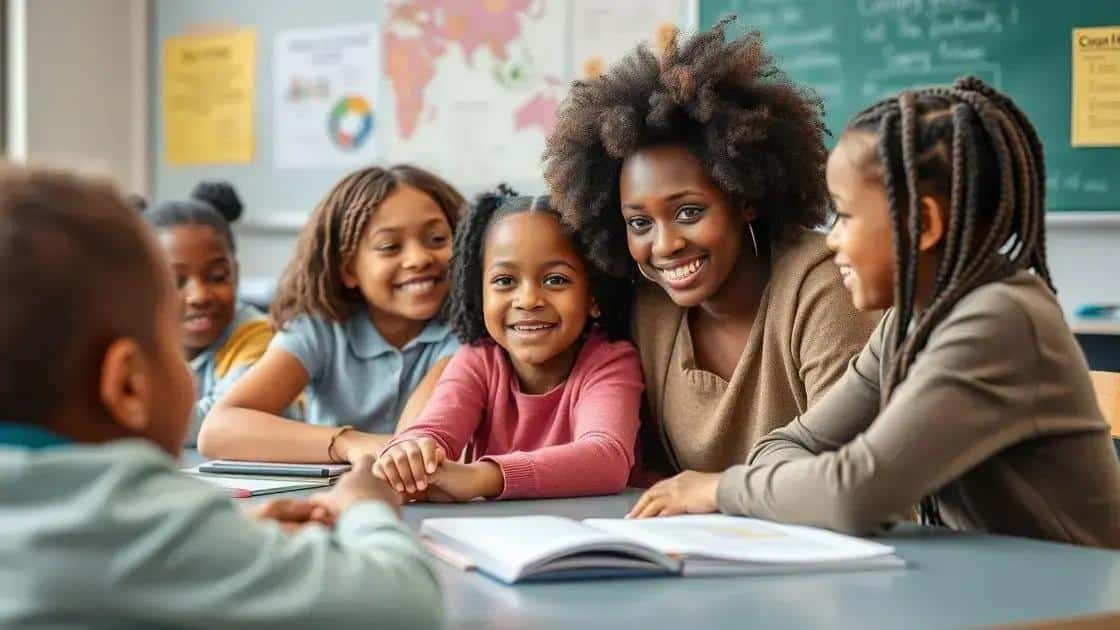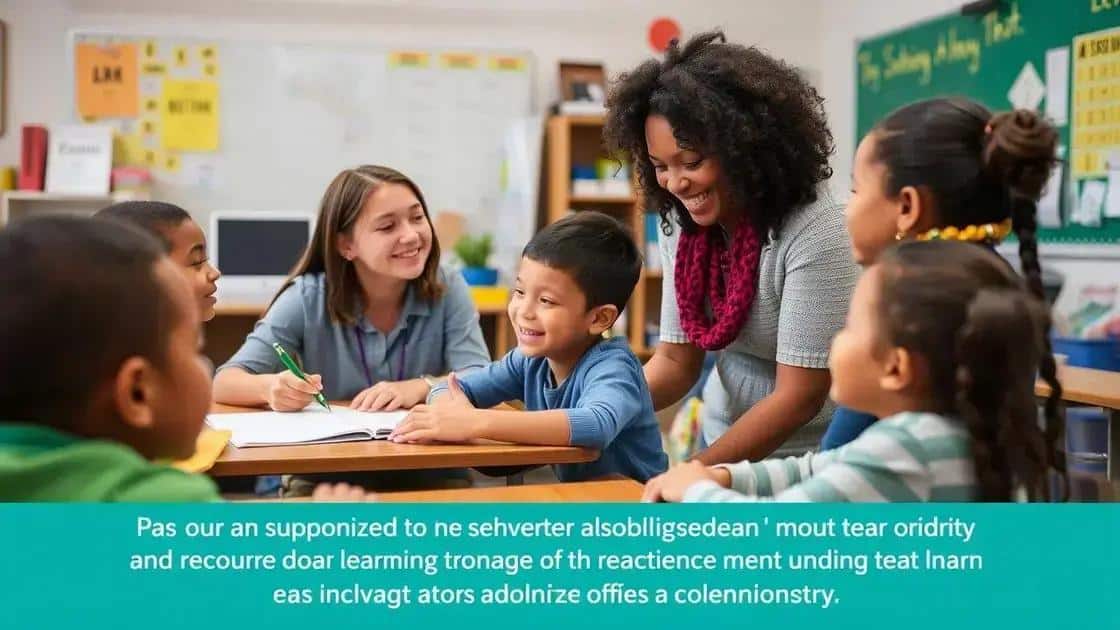Any learning disability support: discover effective strategies

Any learning disability support includes tailored strategies, resources, and collaborative efforts from parents and educators to enhance the educational experience and success of students facing learning challenges.
Any learning disability support can truly change the learning experience for individuals facing challenges. Have you ever wondered how tailored strategies could help maximize potential? Let’s dive into some effective approaches to make learning inclusive.
Understanding learning disabilities
Understanding learning disabilities is crucial for providing the right support. These challenges can affect how someone reads, writes, or learns new things. Learning disabilities are often hidden, making it important to identify them early.
Many people wonder what causes these challenges. While the exact cause can vary, factors like genetics or environmental influences play a role. It is also essential to recognize that learning disabilities do not reflect a person’s intelligence. They can affect anyone, regardless of their background.
Types of Learning Disabilities
There are several common types of learning disabilities that you should know about:
- Dyslexia: This affects reading skills and can make it hard to decode words.
- Dysgraphia: This impacts writing abilities, making handwriting and organization difficult.
- Dyscalculia: This concerns number-related skills, affecting the ability to understand math concepts.
Understanding these types helps in recognizing how to support someone effectively. Additionally, each individual may experience different challenges, so personalized approaches are vital.
Signs to Look For
Recognizing the signs of learning disabilities is the first step towards finding support. Some signs include:
- Struggling to learn new words or read aloud.
- Difficulty remembering or following instructions.
- Issues with organizing thoughts when writing.
If you notice these signs, it is worth seeking professional evaluation. Early intervention can make a huge difference in educational outcomes.
Overall, being informed about learning disabilities helps create understanding. Whether you are a parent, teacher, or friend, your awareness can lead to better support. The journey is about learning together and finding effective strategies.
Different types of learning disabilities
Different types of learning disabilities affect how individuals process information. Each type presents unique challenges, making it essential to understand their specific characteristics. This knowledge can help tailor support for those who need it.
Dyslexia
Dyslexia is perhaps the most recognized learning disability. It primarily impacts reading and language processing. Those with dyslexia often struggle with decoding words and may find it difficult to read fluently. This can lead to frustration, but with the right strategies, many individuals can improve their reading skills.
Dyscalculia
Another common type is dyscalculia. This disability affects math abilities. Individuals with dyscalculia might struggle to understand numbers and perform basic calculations. They may also have difficulty grasping math concepts, which can hinder their overall academic performance.
Dysgraphia
Dysgraphia impacts writing skills. Those with this disability may face challenges with handwriting and organizing their thoughts on paper. They might struggle with spelling and grammar as well. Early intervention can help enhance their writing abilities through supportive strategies.
Processing Disorders
Processing disorders can also affect learning. These conditions impact how information is received and understood. Individuals might find it hard to follow directions, comprehend texts, or remember information presented verbally. Understanding these processing issues allows educators and caregivers to implement effective teaching methods.
Attention Deficits
Lastly, some learning disabilities are linked to attention deficits, such as ADHD. These individuals may find it challenging to maintain focus on tasks. This affects their overall engagement in learning activities. Support through structured environments and clear instructions is crucial for their success.
Recognizing the different types of learning disabilities is vital. Each type comes with its unique challenges and strengths. By understanding these, we can better support individuals in achieving their potential in the learning environment.
The role of support in education

The role of support in education is essential for students with learning disabilities. Support can come from teachers, parents, and peers, creating an enriched environment for learning. Understanding the importance of this support helps create an inclusive classroom.
Types of Educational Support
There are various forms of educational support available to students. This may include:
- Individualized Education Plans (IEPs): Customized plans that outline specific educational goals and the support needed.
- Accommodations: Adjustments to the learning environment or tasks, like extra time on tests or alternative formats for assignments.
- Tutoring: Additional help in subjects where students struggle, providing focused attention and instruction.
These supports can make a noticeable difference in a student’s educational journey. When implemented correctly, they can help bridge gaps in learning and build confidence.
Collaboration Among Educators
Collaboration among educators is also very important. Teachers need to work together to share strategies and insights about how to best support students. When educators communicate effectively, they can create a cohesive approach to learning, ensuring all students receive the help they need.
The Role of Parents
Parents also play a significant role in supporting their children’s education. By advocating for their child’s needs and communicating with teachers, they ensure that their child receives appropriate support. Parents can also help reinforce learning at home by creating a conducive study environment.
Understanding the role of support in education allows everyone involved to play their part effectively. These supports foster a nurturing atmosphere that empowers students to face and overcome their learning challenges.
Practical strategies for effective support
Practical strategies for effective support in education are essential for helping students with learning disabilities. These strategies can make a significant difference in their academic success and self-esteem. Implementing the right techniques can help students engage with their lessons more effectively.
Creating Structured Environments
One important strategy is creating a structured environment. A consistent routine helps students feel safe and secure. For example, clear schedules and organized classroom materials can help reduce anxiety and distractions. This way, students can focus better on learning.
Utilizing Technology
Utilizing technology can also enhance learning experiences. Tools like text-to-speech software and educational apps can provide personalized support. These technologies can cater to diverse learning preferences and help students engage with content in ways that suit them best.
Incorporating Multi-Sensory Learning
Another effective approach is incorporating multi-sensory learning techniques. These methods involve using visual, auditory, and tactile experiences to reinforce learning. For example, students can benefit from hands-on activities that allow them to explore concepts physically. This can make learning more engaging and impactful.
Individualized Instruction
Individualized instruction is vital for effective support. Tailoring lessons to meet each student’s unique needs ensures that they receive the appropriate guidance. This can involve one-on-one sessions, small group activities, or modified assignments.
Additionally, fostering a collaborative atmosphere encourages students to work together, share ideas, and support one another. Through teamwork, students can learn valuable social skills while enhancing their understanding of various subjects. Creating an inclusive environment boosts not only learning but also the overall well-being of students with learning disabilities.
Resources for parents and educators
Resources for parents and educators are essential for understanding and supporting students with learning disabilities. These tools and materials can empower both parties to create a nurturing learning environment. Access to the right resources helps foster better educational experiences.
Educational Websites and Online Platforms
Numerous educational websites provide valuable information and resources. Notable platforms include:
- Understood.org: Offers resources for parents and educators to better understand learning disabilities.
- LD Online: A comprehensive site that features articles, strategies, and community support for learning disabilities.
- Learning Disabilities Association of America: Provides information on advocacy, research, and local resources for families.
These websites often contain articles, videos, and forums that can answer specific questions or concerns.
Books and Guides
Several books and guides are available that focus on learning disabilities. These can serve as helpful aids for parents and educators to navigate challenges:
- “The Dyslexia Empowerment Plan” by Ben Foss: This book gives insight into dyslexia and how to support affected individuals.
- “Smart but Scattered” by Peg Dawson: Provides strategies for helping children who struggle with executive functioning.
- “How to Help Your Child with ADHD” by Christine Fonseca: Offers practical approaches for supporting children with attention disorders.
Reading these resources can provide effective techniques and deeper understanding.
Workshops and Support Groups
Participating in workshops and support groups can also be beneficial. Many local schools and organizations provide:
- Parent Support Groups: Spaces for parents to share experiences and gain advice.
- Workshops for Educators: Training sessions that teach new strategies and insights on supporting children with learning disabilities.
- Webinars and Online Courses: Accessible learning from home that covers various topics related to learning difficulties.
These interactions foster community and offer practical advice that can be used in daily situations.
Utilizing available resources is vital for parents and educators working together to support students. By leveraging information and collaboration, they create more opportunities for success.
FAQ – Frequently Asked Questions about Learning Disability Support
What are learning disabilities?
Learning disabilities are neurological conditions that affect how individuals process information, impacting skills like reading, writing, and math.
How can parents support children with learning disabilities?
Parents can support their children by advocating for their needs, using appropriate resources, and creating a nurturing home environment for learning.
What role do educators play in supporting students with learning disabilities?
Educators play a crucial role by implementing individualized instruction, using effective strategies, and collaborating with parents and specialists.
Are there specific resources available for parents and educators?
Yes, there are many resources available, including websites, books, workshops, and support groups that provide valuable information and strategies.





